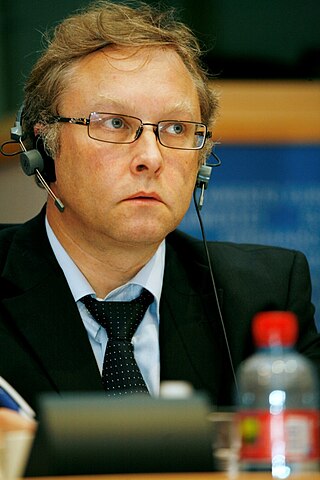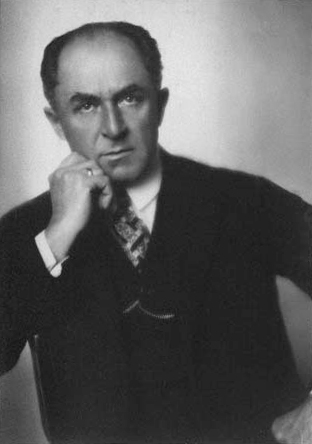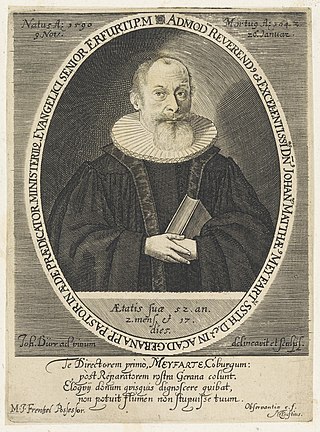
Leonhard Ragaz was a Swiss Reformed theologian and, with Hermann Kutter, one of the founders of religious socialism in Switzerland. He was influenced by Christoph Blumhardt. He was married to the feminist and peace activist Clara Ragaz-Nadig.

Ludger was a missionary among the Frisians and Saxons, founder of Werden Abbey and the first Bishop of Münster in Westphalia. He has been called the "Apostle of Saxony".
Adolf III of Berg was count of Berg from 1093 until 1132, and count of Hövel from 1090 until 1106, and Vogt of Werden. He was the son of Adolf II of Berg-Hövel, count of Berg, and Adelaide of Lauffen.

Kontakte is an electronic music work by Karlheinz Stockhausen, realized in 1958–60 at the Westdeutscher Rundfunk (WDR) electronic-music studio in Cologne with the assistance of Gottfried Michael Koenig. The score is Nr. 12 in the composer's catalogue of works, and is dedicated to Otto Tomek.

The Free Workers' Union of Germany was an anarcho-syndicalist trade union in Germany. It stemmed from the Free Association of German Trade Unions (FDVG) which combined with the Ruhr region's Freie Arbeiter Union on September 15, 1919.
Dieter Claessens was a German sociologist and anthropologist.

Wolfgang Kraushaar is a political scientist and historian. After a residency at the Hamburger Institut für Sozialforschung from the 1980s until 2015. In 2015 he continued his research at the Hamburg Foundation for the Promotion of Science and Culture also in Hamburg, Germany.
Siegfried Flügge was a German theoretical physicist who made contributions to nuclear physics and the theoretical basis for nuclear weapons. He worked on the German nuclear energy project. From 1941 onward he was a lecturer at several German universities, and from 1956 to 1984, editor of the 54-volume, prestigious Handbuch der Physik.

Ingo Zechner is a philosopher and historian. He is the Director of the Ludwig Boltzmann Institute for Digital History (LBIDH) in Vienna.
Neue Marx-Lektüre or NML is a revival and interpretation of Karl Marx's critique of political economy, which originated during the mid-1960s in both Western and Eastern Europe and opposed both Marxist–Leninist and social democratic interpretations of Marx. Neue Marx-Lektüre covers a loose group of authors primarily from German-speaking countries who reject certain historicizing and empiricist interpretations of Marx's analysis of economic forms, many of which are argued to spring from Friedrich Engels role in the early Marxist workers' movement.
The actual boundaries of the Ruhr vary slightly depending on the source, but a good working definition is to define the Lippe and Ruhr as its northern and southern boundaries respectively, the Rhine as its western boundary, and the town of Hamm as the eastern limit.

The Saxon revolt refers to the struggle between the Salian dynasty ruling the Holy Roman Empire and the rebel Saxons during the reign of Henry IV. The conflict reached its climax in the period from summer 1073 until the end of 1075, in a rebellion that involved several clashes of arms.

Ludger Fischer is a German historian on building history, reviewer of contemporary architecture and political scientist.

The German Mining Museum in Bochum or DBM is one of the most visited museums in Germany with around 365,700 visitors per year (2012). It is the largest mining museum in the world, and a renowned research establishment for mining history.
August Ritter von Kral was an Austrian diplomat.

Hugo Reichenberger was a German conductor and composer.

Johann Matthäus Meyfart, also Johann Matthaeus Meyfahrt, Mayfart was a German Lutheran theologist, educator, academic teacher, hymn writer and minister. He was an opponent fighter of witch trials.
Birgit Lodes is a German musicologist and professor at the University of Vienna.
Tiburtius Tibor Kneif was a German-Hungarian lawyer and musicologist.
Uwe Wesel was a German academic, lawyer, and legal historian. He taught at the Free University of Berlin (FU).
This page is based on this
Wikipedia article Text is available under the
CC BY-SA 4.0 license; additional terms may apply.
Images, videos and audio are available under their respective licenses.










